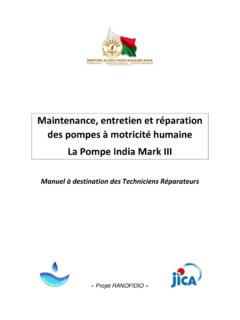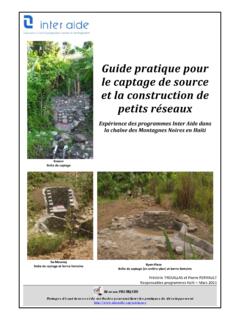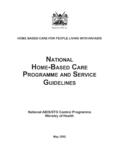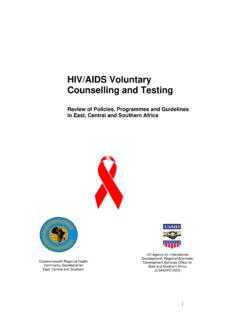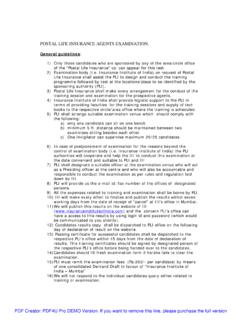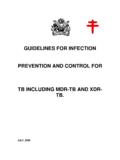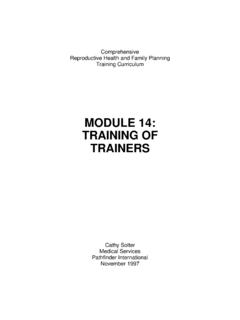Transcription of MORINGA OLEIFERA CULTIVATION TRAINING …
1 Pratiques Network Sharing experiences to enhance the quality and impact of development programmes MORINGA OLEIFERA CULTIVATION TRAINING GUIDELINES1 For field officers and coordinators (Agro Chadza 2012) I. WHY CULTIVATING MORINGA ? MORINGA is one of the world s most useful plants. This fast-growing tree is grown for human food, livestock forage, medicine, dye, composting, and water purification. MORINGA is one of the world s most nutritious crops. The leaves of MORINGA have more beta-carotene than carrots, more protein than peas, more vitamin C than oranges, more calcium than milk, more potassium than bananas, and more iron than spinach.
2 In short : MORINGA represents an available source of essential nutrients and proteins during the all year. It s a strong immune booster. It is a mean to cure and prevent malnutrition in infants, pregnant and lactating women MORINGA produces more leaves during the rainy season which correspond to the hunger period MORINGA is easy to grow, process and add into the meal (tea, relish, soup, ..) MORINGA dried powder can be sold in local markets (Mitundu, Lilongwe, ..) II. PLANTING METHODS Direct sowing Sowing and transplanting of young seedlings Stem cuttings Sowing : 2 or 3 seeds per planting station at 2 cm depth Spacing : 50 cm to 1 m for only leaf production and 3 to 5 m for seed, leaf and pod production.
3 MORINGA develops more easily and grows stronger with direct sowing. Make sure that the young seedlings can be easily noticed and well protected from animals, children and other dangers. Compared to trees planted from seed, trees from stem cuttings grow faster but develop a shallow root system that makes them more susceptible to moisture stress and wind damage. Make stem cuttings using branches of a tree that is at least one year old. Use hard wood and avoid using young green stem tissue. Cuttings can be 45 150 cm long. Cuttings can be dried in the shade for three days before planting in the nursery or in the field.
4 Plant one-third of the length in the soil ( , if the cutting is 90 cm long, plant it 30 cm deep). Add compost to infertile soils to encourage root development. Irrigate regularly to keep the soil moist but not wet. Irrigate newly transplanted trees immediately after transplanting to promote early root development. In dry and arid climates, irrigate regularly for the first two months. Once established, MORINGA rarely need watering. Remark: MORINGA is susceptible to water logging and needs well drained soil. To increase chances of success, farmers are advised to start planting at least more than 10 seedlings in a sandy-loamy soil. 1 Main sources: and Suggested Cultural Practices for MORINGA , AVDRC pub # 03-545, March 2003.
5 Conception and implementation of development programs Pratiques Network Sharing experiences to enhance the quality and impact of development programmes III. PRUNING MORINGA should be trimmed to promote branching, increase yields, and facilitate harvesting. If left to grow without cutting the main trunk, the fast-growing tree will grow straight and tall producing leaves and pods only on the primary stem. To encourage the development of many branches and pods within easy reach from the ground, prune the apical growing shoot (10 cm from the top), when the tree is 0,6 to 1 m high ( ), usually 3 to 5 month after planting. Use a sharp cutting knife, panga knife, or pruning saw to make smooth cuts.
6 New shoots will emerge from just below where the cut is made. Few months after and regularly, cut the growing tips of the branches so that the tree will become bushier (cut at 10 cm each time they reach 20 cm, ). It will produce a shrub with leaves easy to collect ( ). Another pruning strategy is to cut back each branch by 30 cm when it reaches 60 cm in length. This will produce a multi-branched shrub. Older trees that are unproductive or too high for easy harvesting can be pruned at ground level. Farmers should do at least 2 pruning per year, and harvesting can be the occasion to prune. IV. HARVESTING Leaves can be harvested starting from 6 to 12 months after planting, depending on the growth of the tree, the kind of pruning and the watering (well pruned and watered trees can be harvested earlier).
7 Harvest leaves by snapping leaf stems from branches. Harvesting young shoot tips will promote development of side branches where cuts along the main branches are made. Allow plants to develop new shoots and branches before subsequent harvests. Leaves harvested in the middle branches are less bitter and softer than the ones at extremity. If plants are grown at closer spacing and higher density, cut plants about 10 20 cm above ground. Older leaves will need to be stripped from their tough and wiry stems. These leaves are more suited to making dried leaf powder, since stems can be removed during the sifting process.
8 For fresh vegetables, tie harvested leaves in bundles and place them under shade to maintain freshness. The leaflets can also be dried for a few hours and then stored for consumption during the hot-wet season, a time when minerals and vitamins are most lacking in diets. Flowers and pods are normally produced during the second year of growth. Harvest pods when they are young, tender, and green. They are eaten as green beans. Fresh or dried flowers are used for making teas. V. DRYING MORINGA LEAVES MORINGA leaves should be dried in an area protected from light to prevent the loss of vitamins and protected from dust and pests to prevent contamination.
9 If necessary, MORINGA leaves can be covered by thin cloth or mosquito netting to help keep them clean while drying. The drying process should be completed as quickly as possible to prevent the growth of moulds; if leaves mould or mildew they should be thrown out or used for compost. If the humidity of the air is high, the MORINGA leaves Pratiques Network Sharing experiences to enhance the quality and impact of development programmes should be spread out in a thin layer and mixed frequently. Farmers can hang MORINGA leaf bunches from roof or porch with string. VI. STORING MORINGA LEAF POWDER MORINGA Leaf Powder should be stored in air-tight containers protected from heat, humidity and light.
10 If the MORINGA leaves powder is not adequately dried or stored it could encourage the growth of molds or mildews which could cause problems ranging from unpleasant to harmful. If stored MORINGA powder is exposed to heat or light it will degrade and the nutrient content will be reduced. MORINGA Leaf Powder can be stored for up to 6 months under the following conditions: clean, dried powder stored in air-tight containers, protected from light and humidity, and kept below 24 C. VII. COOKING MORINGA LEAVES A) Fresh MORINGA Leaves ( MORINGA Relish) The fresh leaves can be added to any type of relish or soup. The less they are cooked, the better the nutrients will be preserved.
